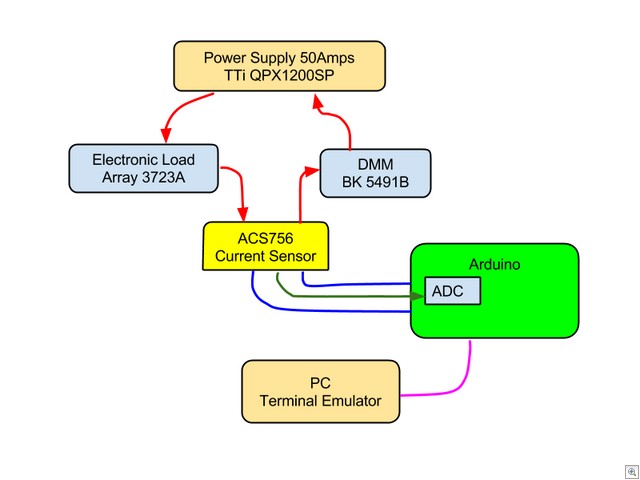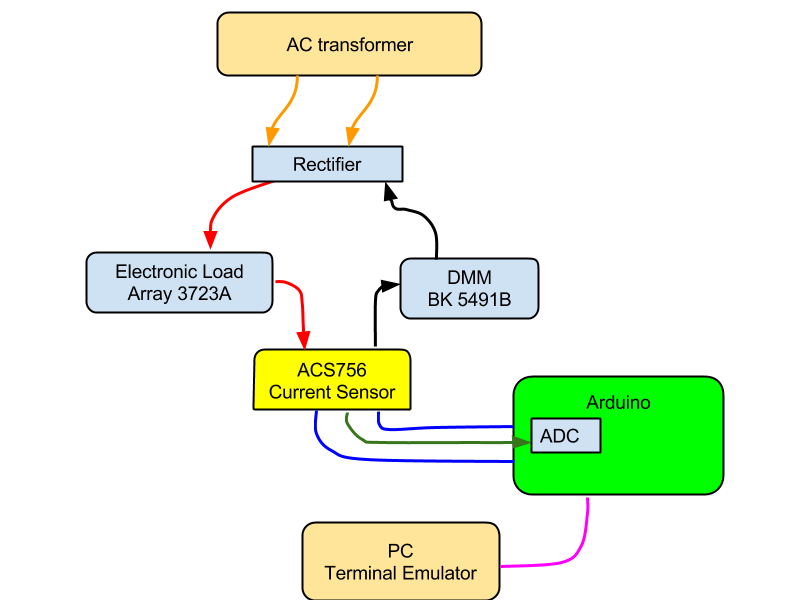Using the Cirrus Logic CS5464 for AC Current Measurement

Continuing the series on examining devices to measure AC current, this time we’ll try out the CS5464 from Cirrus Logic. I initially built it up on a breadboard, but I’ll skip writing up this test and instead build up a prototype and run AC line power through it.
This is a Three-channel, Single-phase Power/Energy monitoring chip, and also can use current shunts and is intended for power meters.
This device provides no direct isolation, instead the entire device (input and output) directly coupled to the AC power line. Any isolation must be provided separately.
Taking a look at the project
Goals:
- Monitor AC line voltage from 80 to 150 VAC RMS
- check for low and high voltage conditions
- stretch goal: identify short duration brown-outs and voltage spikes, the type caused by sudden switching of loads
Monitor AC current on 2 separate loads on the same AC circuit (phase)
- Measure instantaneous current from 0 to 10 Amps, with 0.5 Amp accuracy
- Detect low current and overcurrent conditions
- Stretch goal: identify surges during load switching
The CS5464 chip is really a standalone ASIC device that reads multiple ADC inputs and tracks the values on its own without external intervention.
It has a built-in voltage reference, and temperature sensor for automatic compensation.
It simultaneously tracks a variety of values for each channel, including:
- Instantaneous Current
- Instantaneous Voltage
- Instantaneous Power
- Active Power Channel
- RMS Current Channel
- RMS Voltage Channel
That’s just fantastic for my purposes!
This device should meet the goals of identifying brownouts, voltage spikes, and current surges without lots of reads or external processing. It should really lower the demands on the main microcontroller, allowing the core processor to focus on control and reporting functions… it should only need to ping the CS5464 occasionally to get the necessary data.
The CS5464 does indeed have a lot of functionality, but it also comes with a lot more complexity, it requires being reset properly after power-up and various configuration commands before you can get the data you’re after.
Cirrus application note
Prototyping with the CS5464 device can be quite simple, if you just want to simulate the AC power/current flowing through a small shunt using a function generator or other safe, low-voltage source.
But, if you want to use it safely with non-isolated AC line voltage, in a real-world situation, then it gets a little more complex.
To provide some margin of safety, I have separated the CS5464 measurement device from the microcontroller (here it’s an Arduino), using the ADuM41xx series galvanic digital isolators from Analog Devices.
But, the CS5464 and the “line side” of the couplers need power… This could be provided by a non-isolated capacitive drop approach, like this one in the application notes:
But, since I already have nice clean power for my microcontroller, I can just use a 5010 Iso-Power device. It’s small and needs few components.
Here’s the test setup:
Even if I have to power all 8 channels on the ADum7441 devices, the total power will be 25ma, which should be okay for the IsoPower chip to run.
Here’s the prototype, built up on perfboard. Sections of the board are marked:
Red is the AC input/shunt section
Green indicates the isolated, low voltage section that connects to the microcontroller
The unmarked area is logic-level signalling, but is tied directly to the AC line (no isolation)
Testing
I tested the prototype board measuring AC (line) current using a set of 150W lamps.
The test load is connected to the AC power and shunt via the IEC plug that is broken out to insulated spade connectors.
Test Results:
|
Input (Amps) |
Shunt Reading (mV) |
Counts |
Counts, less 395 offset |
Counts per Amp |
|
0 |
0.045 |
395 |
||
|
1.21 |
12.155 |
2444 |
2049 |
1693 |
|
2.41 |
24.152 |
4488 |
4093 |
1698 |
|
3.58 |
35.96 |
6500 |
6105 |
1705 |
The results are very linear, with only a little, steady increase in counts as the current rose. This could have been caused by thermal drift as the shunt warmed up under load.
Here’s some sample code for working with the CS5464. This code is not really my own, as much of it is a collection of snippets that I came across. I’ll see if I can find the original sources and reference those.
// ** updated 6/26/2015 **
// This is written for an Arduino Leonardo.
// - it uses Serial1 instead of Serial, if you change it to Serial it should work for an UNO or other boards
//
// For CS5464 chip from Cirrus
// Read the peak current on channel I2
// Check for zero value coming back from CS5464, if so, then reset the device
#include <SPI.h>
// Pin configurations
// set pin 12 as the slave select for the digital pot:
const int slaveSelectPin = 12;
// set pin 11 as the Reset pin for the CS5464:
const int resetPin = 11;
// Create a data type for the 4 Byte data and command packet
union FourByte {
struct {
unsigned long value: 24; //24bit register values go in here
byte command: 8; //8bit command goes in here.
};
byte bit8[4]; //this is just used for efficient conversion of the above into 4 bytes.
};
// Initialize SPI and pins
void setup() {
// reset the CS5464 device
pinMode(resetPin, OUTPUT);
delay(100);
digitalWrite(resetPin, LOW);
delay(100);
digitalWrite(resetPin, HIGH);
delay(100);
SPI.begin();
SPI.setBitOrder(MSBFIRST);
SPI.setDataMode(SPI_MODE3); //I believe it to be Mode3
SPI.setClockDivider(SPI_CLOCK_DIV16);
pinMode(slaveSelectPin, OUTPUT); // Do this manually, as the SPI library doesn't work right for all versions.
digitalWrite(slaveSelectPin, HIGH);
Serial1.begin(9600);
delay(5000); // Pause allowing time to open the serial monitor
Serial1.println("setup...");
//Perform software reset:
SPI_writeCommand(0x80);
delay(2000);
unsigned long status;
do {
status = SPI_read(0b00011110); //read the status register
status &= (1UL << 23);
} while (!status);
// SPI_writeCommand(0xE0); //Set single conversion mode
SPI_writeCommand(0xE8); //Set continuous conversion mode
/*
// Print the configuration register, to confirm communication with the CS5464
check = SPI_read(0x00); //read the config register.
Serial1.print("Config = ");
Serial1.println(check, HEX);
*/
/*
//example of writing a register
union FourByte data;
data.command = 0b01000000; //Write to config register
data.value = 1; //This is the default value from datasheet, just using it as an example.
SPI_writeRegister(data);
*/
}
// Main loop
void loop() {
delay(1000);
//example of reading data
// unsigned long voltage = SPI_read(0b00001110); //read Register 7 Instantaneous Current Channel 2
unsigned long voltage = SPI_read(0b00101100); //read Register 22 Peak Current Channel 2
voltage = voltage >> 8;
Serial1.print("Peak Current = ");
Serial1.print(voltage, HEX);
Serial1.print (" ");
Serial1.println(voltage);
// check if the device has accidentally reset
// Found that noise from switching AC loads can cause the CS5464 to lock-up.
// need to improve power or signal filtering, but this is a patch for initial testing.
if (voltage == 0) { // If we get a 0 reading, then reconfigure the device
SPI_writeCommand(0xE8); //Set continuous conversion mode
delay(1000);
unsigned long check = SPI_read(0x00); //read the config register.
Serial1.print("Config = ");
Serial1.println(check, HEX);
}
}
// Send a Command to the CS5464 - see the data sheet for commands
void SPI_writeCommand(byte command) {
digitalWrite(slaveSelectPin, LOW); //SS goes low to mark start of transmission
union FourByte data = {0xFEFEFE, command}; //generate the data to be sent, i.e. your command plus the Sync bytes.
Serial.print("SPI_writeCommand:");
for (char i = 3; i >= 0; i--) {
SPI.transfer(data.bit8[i]); //transfer all 4 bytes of data - command first, then Big Endian transfer of the 24bit value.
Serial.print(data.bit8[i], HEX);
}
Serial.println();
digitalWrite(slaveSelectPin, HIGH);
}
// Read a register from the CS5464 - just supply a command byte (see the datasheet)
unsigned long SPI_read(byte command) {
digitalWrite(slaveSelectPin, LOW); //SS goes low to mark start of transmission
union FourByte data = {0xFEFEFE, command}; //generate the data to be sent, i.e. your command plus the Sync bytes.
// Serial.print("SPI_Read:");
for (char i = 3; i >= 0; i--) {
data.bit8[i] = SPI.transfer(data.bit8[i]); //send the data whilst reading in the result
// Serial.print(data.bit8[i], HEX);
}
// Serial.println();
digitalWrite(slaveSelectPin, HIGH); //SS goes high to mark end of transmission
return data.value; //return the 24bit value recieved.
}



